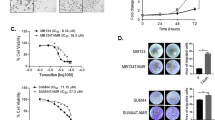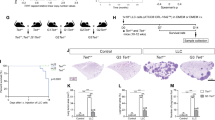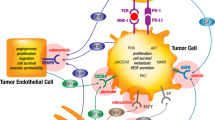Abstract
Aim:
Dexamethasone (DEX) is a widely used synthetic glucocorticoid, which has shown anti-cancer efficacy and anti-estrogenic activity. In this study we explored the possibility that DEX might be used as an endocrine therapeutic agent to treat human non-small cell lung cancer (NSCLC).
Methods:
The viability and proliferation of human NSCLC cell lines A549 and H1299 were assessed in vitro. Anti-tumor action was also evaluated in A549 xenograft nude mice treated with DEX (2 or 4 mg·kg−1·d−1, ig) or the positive control tamoxifen (50 mg·kg−1·d−1, ig) for 32 d. The expression of estrogen sulfotransferase (EST) in tumor cells and tissues was examined. The intratumoral estrogen levels and uterine estrogen responses were measured.
Results:
DEX displayed mild cytotoxicity to the NSCLC cells (IC50 >500 μmol/L) compared to tamoxifen (IC50 <50 μmol/L), but it was able to inhibit the cell proliferation at low micromolar ranges. Furthermore, DEX (0.1–10 μmol/L) dose-dependently up-regulated EST expression in the cells, and inhibited the cell migration in vitro. Triclosan, a sulfation inhibitor, was able to diminish DEX-caused inhibition on the cell viability. In A549 xenograft nude mice, DEX or tamoxifen administration remarkably suppressed the tumor growth. Moreover, DEX administration dose-dependently increased EST expression in tumor tissues, and reduced intratumoral estrogen levels as well as the volumes and weights of uterine.
Conclusion:
DEX suppresses the growth of A549 xenograft tumors via inducing EST and decreasing estradiol levels in tumor tissues, suggesting that DEX may be used as anti-estrogenic agent for the treatment of NSCLC.
Similar content being viewed by others
Log in or create a free account to read this content
Gain free access to this article, as well as selected content from this journal and more on nature.com
or
References
Siegel R, Naishadham D, Jemal A . Cancer statistics, 2013. CA Cancer J Clin 2013; 63: 11–30.
Márquez-Garbán DC, Chen HW, Fishbein MC, Goodglick L, Pietras RJ . Estrogen receptor signaling pathways in human non-small cell lung cancer. Steroids 2007; 72: 135–43.
Marquez-Garban DC, Chen HW, Goodglick L, Fishbein MC, Pietras RJ . Targeting aromatase and estrogen signaling in human non-small cell lung cancer. Ann N Y Acad Sci 2009; 1155: 194–205.
Burns TF, Stabile LP . Targeting the estrogen pathway for the treatment and prevention of lung cancer. Lung Cancer Manag 2014; 3: 43–52.
Baik CS, Eaton KD . Estrogen signaling in lung cancer: an opportunity for novel therapy. Cancers (Basel) 2012; 4: 969–88.
Siegfried JM . Women and lung cancer: does oestrogen play a role? Lancet Oncol 2001; 2: 506–13.
Hsu LH, Liu KJ, Tsai MF, Wu CR, Feng AC, Chu NM, et al. Estrogen adversely affects the prognosis of patients with lung adenocarcinoma. Cancer Sci 2015; 106: 51–9.
Shen H, Yuan Y, Sun J, Gao W, Shu YQ . Combined tamoxifen and gefitinib in non-small cell lung cancer shows antiproliferative effects. Biomed Pharmacother 2010; 64: 88–92.
Garon EB, Pietras RJ, Finn RS, Kamranpour N, Pitts S, Marquez-Garban DC, et al. Antiestrogen fulvestrant enhances the antiproliferative effects of epidermal growth factor receptor inhibitors in human non-small-cell lung cancer. J Thorac Oncol 2013; 8: 270–8.
Shen L, Li Z, Shen S, Niu X, Yu Y, Li Z, et al. The synergistic effect of EGFR tyrosine kinase inhibitor gefitinib in combination with aromatase inhibitor anastrozole in non-small cell lung cancer cell lines. Lung Cancer 2012; 78: 193–200.
Pasqualini JR . Estrogen sulfotransferases in breast and endometrial cancers. Ann N Y Acad Sci 2009; 1155: 88–98.
Suzuki T, Nakata T, Miki Y, Kaneko C, Moriya T, Ishida T, et al. Estrogen sulfotransferase and steroid sulfatase in human breast carcinoma. Cancer Res 2003; 63: 2762–70.
Fu J, Weise AM, Falany JL, Falany CN, Thibodeau BJ, Miller FR, et al. Expression of estrogenicity genes in a lineage cell culture model of human breast cancer progression. Breast Cancer Res Treat 2010; 120: 35–45.
Zhang H, Varlamova O, Vargas FM, Falany CN, Leyh TS . Sulfuryl transfer: the catalytic mechanism of human estrogen sulfotransferase. J Biol Chem 1998; 273: 10888–92.
Ji XW, Chen GP, Song Y, Hua M, Wang LJ, Li L, et al. Intratumoral estrogen sulfotransferase induction contributes to the anti-breast cancer effects of the dithiocarbamate derivative TM208. Acta Pharmacol Sin 2015; 36: 1246–55.
Gong H, Jarzynka MJ, Cole TJ, Lee JH, Wada T, Zhang B, et al. Glucocorticoids antagonize estrogens by glucocorticoid receptor-mediated activation of estrogen sulfotransferase. Cancer Res 2008; 68: 7386–93.
Xu Y, Liu X, Guo F, Ning Y, Zhi X, Wang X, et al. Effect of estrogen sulfation by SULT1E1 and PAPSS on the development of estrogen-dependent cancers. Cancer Sci 2012; 103: 1000–9.
Herr I, Pfitzenmaier J . Glucocorticoid use in prostate cancer and other solid tumours: implications for effectiveness of cytotoxic treatment and metastases. Lancet Oncol 2006; 7: 425–30.
Wang H, Wang Y, Rayburn ER, Hill DL, Rinehart JJ, Zhang RW . Dexamethasone as a chemosensitizer for breast cancer chemotherapy: Potentiation of the antitumor activity of adriamycin, modulation of cytokine expression, and pharmacokinetics. Int J Oncol 2007; 30: 947–53.
Sau S, Banerjee R . Cationic lipid-conjugated dexamethasone as a selective antitumor agent. Eur J Med Chem 2014; 83: 433–47.
Geng Y, Wang J, Jing H, Wang HW, Bao YX . Inhibitory effect of dexamethasone on Lewis mice lung cancer cells. Genet Mol Res 2014; 13: 6827–36.
Komiya A, Shimbo M, Suzuki H, Imamoto T, Kato T, Fukasawa S, et al. Oral low-dose dexamethasone for androgen-independent prostate cancer patients. Oncol Lett 2010; 1: 73–9.
Rhen T, Grissom S, Afshari C, Cidlowski JA . Dexamethasone blocks the rapid biological effects of 17beta-estradiol in the rat uterus without antagonizing its global genomic actions. FASEB J 2003; 17: 1849–70.
Zhou F, Bouillard B, Pharaboz-Joly MO, Andre J . Non-classical antiestrogenic actions of dexamethasone in variant MCF-7 human breast cancer cells in culture. Mol Cell Endocrinol 1989; 66: 189–97.
Vardy J, Chiew KS, Galica J, Pond GR, Tannock IF . Side effects associated with the use of dexamethasone for prophylaxis of delayed emesis after moderately emetogenic chemotherapy. Br J Cancer 2006; 94: 1011–5.
Ayroldi E, Macchiarulo A, Riccardi C . Targeting glucocorticoid side effects: selective glucocorticoid receptor modulator or glucocorticoid-induced leucine zipper? A perspective. FASEB J 2014; 28: 5055–70.
Vichai V, Kirtikara K . Sulforhodamine B colorimetric assay for cytotoxicity screening. Nat Protoc 2006; 1: 1112–6.
Cheng XL, Zhou TY, Li B, Li MY, Li L, Li ZQ, et al. Methotrexate and 5-aminoimidazole-4-carboxamide riboside exert synergistic anticancer action against human breast cancer and hepatocellular carcinoma. Acta Pharmacol Sin 2013; 34: 951–9.
Wang LQ, Falany CN, James MO . Triclosan as a substrate and inhibitor of 3′-phosphoadenosine 5′-phosphosulfate-sulfotransferase and UDP-glucuronosyl transferase in human liver fractions. Drug Metab Dispos 2004; 32: 1162–9.
Zhou TY, Huang CQ, Chen Y, Xu JJ, Shanbhag PD, Chen GP . Methamphetamine regulation of sulfotransferase 1A1 and 2A1 expression in rat brain sections. Neurotoxicology 2013; 34: 212–8.
Shao X, Li J, Wang S, Chen G, Xu J, Ji X, et al. Exogenous dopamine induces dehydroepiandrosterone sulfotransferase (rSULT2A1) in rat liver and changes the pharmacokinetic profile of moxifloxacin in rats. Drug Metab Pharmacokinet 2015; 30: 97–104.
Ko JC, Tsai MS, Weng SH, Kuo YH, Chiu YF, Lin YW . Curcumin enhances the mitomycin C-induced cytotoxicity via downregulation of MKK1/2-ERK1/2-mediated Rad51 expression in non-small cell lung cancer cells. Toxicol Appl Pharmacol 2011; 255: 327–38.
Houghton P, Fang R, Techatanawat I, Steventon G, Hylands PJ, Lee CC . The sulphorhodamine (SRB) assay and other approaches to testing plant extracts and derived compounds for activities related to reputed anticancer activity. Methods 2007; 42: 377–87.
Medlock KL, Forrester TM, Sheehan DM . Short-term effects of physiological and pharmacological doses of estradiol on estrogen receptor and uterine growth. J Recept Res 1991; 11: 743–56.
Moon EY, Ryu YK, Lee GH . Dexamethasone inhibits in vivo tumor growth by the alteration of bone marrow CD11b(+) myeloid cells. Int Immunopharmacol 2014; 21: 494–500.
Li M, Li Y, Yin Q, Mi R, Chen L, Du J, et al. Treatment with cyclophosphamide, vindesine, cytarabine, dexamethasone and bleomycin in patients with relapsed/refractory diffuse large B-cell lymphoma. Leuk Lymphoma 2014; 55: 1578–83.
Kumar VH, IM NN, Huilgol SV, Yendiger SM, H N, Ch R . Dose dependent hepatic and endothelial changes in rats treated with dexamethasone. J Clin Diagn Res 2015; 9: FF08–10.
Lother SA, Harding GA, Musto G, Navaratnam S, Pitz MW . Antiestrogen use and survival of women with non-small cell lung cancer in Manitoba, Canada. Horm Cancer 2013; 4: 270–6.
Hu R, Hilakivi-Clarke L, Clarke R . Molecular mechanisms of tamoxifen-associated endometrial cancer (Review). Oncol Lett 2015; 9: 1495–501.
Stabile LP, Lyker JS, Gubish CT, Zhang W, Grandis JR, Siegfried JM . Combined targeting of the estrogen receptor and the epidermal growth factor receptor in non-small cell lung cancer shows enhanced antiproliferative effects. Cancer Res 2005; 65: 1459–70.
Xu R, Shen H, Guo R, Sun J, Gao W, Shu Y . Combine therapy of gefitinib and fulvestrant enhances antitumor effects on NSCLC cell lines with acquired resistance to gefitinib. Biomed Pharmacother 2012; 66: 384–9.
Ko JC, Chiu HC, Syu JJ, Jian YJ, Chen CY, Jian YT, et al. Tamoxifen enhances erlotinib-induced cytotoxicity through down-regulating AKT-mediated thymidine phosphorylase expression in human non-small-cell lung cancer cells. Biochem Pharmacol 2014; 88: 119–27.
Johnson MD, Zuo H, Lee KH, Trebley JP, Rae JM, Weatherman RV, et al. Pharmacological characterization of 4-hydroxy-N-desmethyl tamoxifen, a novel active metabolite of tamoxifen. Breast Cancer Res Treat 2004; 85: 151–9.
Yuan Y, Zhou X, Ren Y, Zhou S, Wang L, Ji S, et al. Semi-mechanism-based pharmacokinetic/pharmacodynamic model for the combination use of dexamethasone and gemcitabine in breast cancer. J Pharm Sci 2015; 104: 4399–408.
Petrillo MG, Fettucciari K, Montuschi P, Ronchetti S, Cari L, Migliorati G, et al. Transcriptional regulation of kinases downstream of the T cell receptor: another immunomodulatory mechanism of glucocorticoids. BMC Pharmacol Toxicol 2014; 15: 35.
Lee MJ, Lee KC, Kim HY, Lee WS, Seo WJ, Lee C . Comparison of ramosetron plus dexamethasone with ramosetron alone on postoperative nausea, vomiting, shivering and pain after thyroid surgery. Korean J Pain 2015; 28: 39–44.
Rutz HP . Effects of corticosteroid use on treatment of solid tumours. Lancet 2002; 360: 1969–70.
Egberts JH, Schniewind B, Pätzold M, Kettler B, Tepel J, Kalthoff H, et al. Dexamethasone reduces tumor recurrence and metastasis after pancreatic tumor resection in SCID mice. Cancer Biol Ther 2008; 7: 1044–50.
Acknowledgements
This study was supported by the National Natural Science Foundation of China (Grant No 81273583).
Author information
Authors and Affiliations
Corresponding author
Rights and permissions
About this article
Cite this article
Wang, Lj., Li, J., Hao, Fr. et al. Dexamethasone suppresses the growth of human non-small cell lung cancer via inducing estrogen sulfotransferase and inactivating estrogen. Acta Pharmacol Sin 37, 845–856 (2016). https://doi.org/10.1038/aps.2016.39
Received:
Accepted:
Published:
Issue date:
DOI: https://doi.org/10.1038/aps.2016.39
Keywords
This article is cited by
-
An integrated PK/PD model investigating the impact of tumor size and systemic safety on animal survival in SW1990 pancreatic cancer xenograft
Acta Pharmacologica Sinica (2023)
-
Preclinical PK/PD model for the combinatorial use of dexamethasone and sulpiride in the treatment of breast cancer
Acta Pharmacologica Sinica (2019)
-
Time-dependent pharmacokinetics of dexamethasone and its efficacy in human breast cancer xenograft mice: a semi-mechanism-based pharmacokinetic/pharmacodynamic model
Acta Pharmacologica Sinica (2018)
-
Dopamine D2 receptor antagonist sulpiride enhances dexamethasone responses in the treatment of drug-resistant and metastatic breast cancer
Acta Pharmacologica Sinica (2017)
-
Critical roles of mucin-1 in sensitivity of lung cancer cells to tumor necrosis factor-alpha and dexamethasone
Cell Biology and Toxicology (2017)



